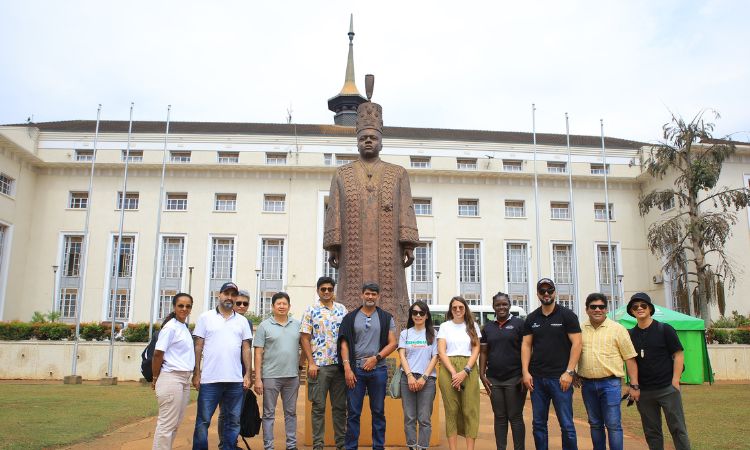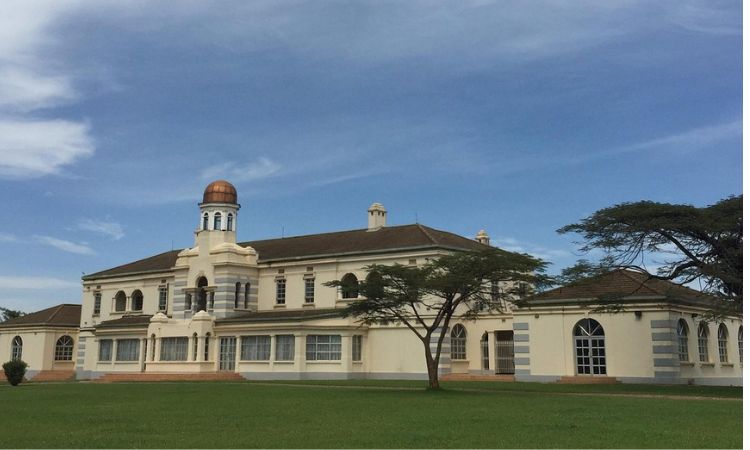Top Guide to Kabaka Palace Uganda | Photos, Entry Fee, tours
Kabaka Palace: Nestled at the top of the verdant Mengo Hill, the Kabaka Palace, also known as Mengo Palace or Lubiri Mengo, stands as the official residence of the Kabaka, the revered king of the Buganda Kingdom.
This iconic Buganda Kingdom Palace in Kampala is more than a royal abode—it’s a living testament to Uganda’s rich heritage, blending ancient traditions with layers of turbulent history.
For travelers seeking authentic attractions in Kampala, a visit to Kabaka’s Palace in Kampala offers an immersive dive into the soul of the Baganda people, the largest ethnic group in Uganda.
At All Uganda Safaris, we specialize in curating unforgettable experiences that connect you to such cultural wonders, making your journey through Uganda’s heartland truly transformative.
As you step into this sprawling compound, you’re not just touring a site; you’re walking through centuries of resilience, royalty, and revolution.
Whether you’re drawn by the whispers of Kabaka Palace history or the chilling echoes of its darker chapters, Kabaka’s Palace tours promise stories that linger long after you leave.

History of the Kabaka Palace
The story of the Kabaka Palace is intrinsically woven into the Buganda Kingdom history, one of Africa’s oldest monarchies dating back to the 14th century.
The current structure, however, traces its origins to 1885, when Kabaka Mwanga II, a bold and controversial ruler, relocated his seat from Masaja to Mengo Hill—renamed after the grinding stones (Emmengo) of the Nvubu clan that once dotted the landscape.
Mwanga’s vision transformed the hill into a fortified hub, symbolizing Buganda’s power amid rising colonial pressures from British missionaries and traders.
The palace’s modern iteration was rebuilt in 1922 after earlier versions fell to fires and conflicts, under the guidance of British architects who infused colonial elements while preserving Baganda aesthetics. It served as the epicenter of royal governance, hosting ceremonies, councils, and clan gatherings.
Kabaka Daudi Chwa II and his son, Kabaka Mutesa II, elevated its stature during the push for Ugandan independence in the 1950s. Mutesa II, who ascended in 1939, turned the palace into a beacon of resistance against colonial overreach, even corresponding with global leaders to advocate for self-rule.
Yet, the palace’s narrative darkened in the post-independence era. In 1966, during the infamous 1966 Crisis, Prime Minister Milton Obote, fearing Mutesa II’s influence as Uganda’s ceremonial president, unleashed a brutal assault.
Obote’s forces, led by a young Idi Amin, stormed the Lubiri Mengo in the Battle of Mengo Hill, shelling the compound and forcing the Kabaka into exile. Mutesa II fled through a window, evading capture, and died in London in 1969.
The palace lay in ruins until its restoration in the 1990s, coinciding with the return of the kingdom under Kabaka Ronald Muwenda Mutebi II in 1993. Today, it embodies renewal, with ongoing renovations ensuring its role as a vibrant cultural nerve center.
This Kabaka Palace history isn’t just dates and dynasties—it’s a saga of survival that captivates history buffs on our Uganda Safaris itineraries.
The 1966 Crisis & Idi Amin Torture Chambers
No discussion of Mengo Palace is complete without delving into its most harrowing chapter: the 1966 Crisis and the infamous Idi Amin torture chambers. The 1966 attack remains a scar on Ugandan memory. On May 24, Obote’s troops bombarded the palace for four days, killing dozens and displacing hundreds.
Kabaka Mutesa II’s desperate escape—leaping from a window onto a waiting getaway vehicle—symbolized the kingdom’s defiance. The assault dismantled Buganda’s autonomy, abolishing kingdoms temporarily and exiling the Kabaka.
The plot thickened under Idi Amin’s 1971-1979 reign of terror. Amin, who orchestrated the 1966 siege, repurposed underground armories within the palace into Idi Amin torture chambers, or Kabaka Palace torture chambers.
These Lubiri underground chambers—dank, windowless bunkers originally built for storage—became sites of unimaginable horror. Political dissidents, suspected spies, and even palace staff were dragged here, subjected to electrocution, beatings, and mock executions. Estimates suggest thousands perished, their fates shrouded in secrecy.
Today, visitors to Kabaka’s Palace in Kampala confront this legacy head-on. Guided tours lead into these chambers, where rusted chains dangle from walls, and faded graffiti etches tales of despair.
Guides recount chilling anecdotes, like the “electric chair” rigged for interrogations or the flooding tactics used to drown victims. It’s a sobering reminder of Uganda’s dark past, but one that fosters reflection on reconciliation.
As part of our cultural tours at All Uganda Safaris, we pair these visits with discussions on healing, ensuring the experience educates without overwhelming.

Architecture & Layout of the Kabaka’s Palace
Spanning an impressive how big is Lubiri Palace? The Lubiri Mengo compound covers approximately 260 acres (about 1.6 square miles), making it one of East Africa’s largest royal enclaves.
This vast expanse, encircled by a high perimeter wall, includes manicured gardens, ceremonial lawns, and over 50 clan-representative posts lining the Royal Mile—a straight avenue linking the palace to the Buganda Parliament (Bulange).
Architecturally, Mengo Palace fuses traditional Baganda elements with British colonial influences. The main residence, Twekobe (meaning “the beautiful one”), boasts thatched roofs, intricate wooden carvings depicting royal motifs, and whitewashed walls evoking purity and authority.
Key structures include the Kabaka’s private quarters (off-limits to visitors), administrative offices, and a pictorial gallery showcasing royal artifacts—from Mutesa I’s letter to Queen Victoria to coronation regalia.
The layout is strategically symbolic: the courthouse faces the main gate for vigilant oversight, while inner courtyards host private rituals. Reed fences and banana groves add layers of cultural camouflage, blending seamlessly with the undulating hills.
Wandering these grounds on a Kabaka’s Palace tour feels like stepping into a living blueprint of Buganda’s hierarchical society.
Kabaka’s Lake Connection
Adjoining the palace, Kabaka’s Lake—the largest man-made lake in Uganda—adds a serene aquatic dimension to the experience.
What is the history of Kabaka’s Lake? Dug between 1885 and 1888 on orders of Kabaka Mwanga II, it involved over 3,000 laborers from 52 Buganda clans, hand-excavating a 2-kilometer channel toward Lake Victoria.
Mwanga envisioned it as an escape route amid conflicts with Christian converts and British forces, but also as a waterway for fishing, swimming, and linking to his Mulungu Hill retreat.
Tragedy marred its creation: 11 months of grueling work claimed lives to disease and exhaustion, halted by the 1888 religious wars. Spanning 2 square kilometers and plunging 200 feet deep, the lake now teems with waterbirds and features a tree-shaded island accessible by canoe. Its connection to the palace? A discreet channel allowed discreet royal exits, underscoring Mwanga’s ingenuity.
Activities abound: picnic by the shores, birdwatch otters and herons, or paddle to the island for folklore from local guides. Many Kabaka Palace tours extend here, offering a tranquil counterpoint to the palace’s intensity. At All Uganda Safaris, we recommend combining it with a sunset boat ride for that perfect cultural-nature fusion.
What to Expect on a Kabaka Palace Tour
Embark on a Kabaka’s Palace tours for an enriching 1-2 hour guided journey that unveils the site’s soul. Starting at the main gate, your Baganda guide—often a clan descendant—briefs on Buganda’s origins, the Kabaka’s duties, and clan dynamics. Expect to stroll the Royal Mile, admiring the 54 clan posts, then view the palace exterior and Twekobe’s grandeur.
Highlights include the pictorial gallery with royal photos and artifacts, and the stark descent into the Idi Amin torture chambers, where you’ll hear survivor tales amid the eerie silence.
Tours touch on bark cloth demonstrations—a UNESCO-recognized craft—and end at the gardens for reflection. Photography is permitted outdoors but restricted inside chambers; no flash, please, to honor the solemnity.
Cultural etiquette: Greet with a respectfully, remove hats indoors, and avoid pointing at sacred sites. Tours are family-friendly but intense for young children due to historical themes.
Is Kabaka Palace open to tourists? Absolutely—daily, with English, Luganda, or French options. Can you take photos inside the torture chambers? Limited; ask your guide. Contact us today to book a tour to Kabaka’s Palace.

Kabaka’s Palace Entrance Fees
Practicality matters for seamless visits. The Kabaka Palace entrance fee in 2025 is UGX 37,000 (about $10 USD) for foreign non-residents, payable by card at the gate booth.
Locals pay UGX 5,000-10,000, with group rates (10+ people) at UGX 30,000 per foreigner. Children under 12 enter free. Tickets cover the guided tour; optional lake extensions add UGX 20,000.
Opening hours: 9 AM to 5 PM daily, though closing can vary—aim for mornings to beat crowds. Buy tickets on-site; no advance booking needed. This transparency helps us to plan your budget effortlessly.
Location & How to Get There
Perched on Mengo Hill, the Kabaka Palace location is at Kabaka Anjagala Road, Mengo, just 3 km southwest of Kampala’s city center.
From Entebbe International Airport, it’s a 45-minute drive via the Entebbe Road. Note: Uganda palace Entebbe refers to State House, a separate presidential site—not the Kabaka’s.
How to get to Lubiri Mengo? From Kampala’s taxi parks, hop a matatu (minibus) to Mengo for UGX 2,000 (under $1), alighting at the Royal Mile. Boda-bodas (motorcycle taxis) cost UGX 5,000-10,000 from downtown.
For comfort, our tour guides navigate the hilly ascent, parking at the secure entrance. The compound’s hilltop perch offers panoramic views—textual map: Head south on Nasser Road from the city center, turn left onto Kabaka Anjagala for the iconic gates.
Best Time to Visit Kabaka’s Palace
Timing elevates your Mengo Palace adventure. Weekdays (Monday-Thursday) mean fewer crowds, ideal for intimate tours. Mornings (9-11 AM) catch cooler weather and golden light for photos.
Uganda’s equatorial climate is year-round pleasant, but dry seasons (June-August, December-February) minimize rain-slicked paths. Avoid peak holidays like Buganda’s June coronation anniversaries for elbow room.
Why Visit the Kabaka Palace?
In a world of fleeting sights, Kabaka Palace delivers enduring value. Its cultural significance as the traditional palace of the Kabaka—the spiritual and political core of Buganda—immerses you in rituals like clan dances and royal drumming.
The historical value spans resilience against colonialism and tyranny, while unique attractions like the torture chambers and lake provide raw, unfiltered narratives. It’s not just a stop; it’s a portal to understanding Uganda’s mosaic identity.
Pair it with nearby gems like the Gaddafi Mosque (2 km away, for Islamic heritage) or Uganda Martyrs Shrine (10 km north, honoring early Christian converts) for a full-day heritage circuit. As a Uganda trusted tour operator, we craft these into bespoke itineraries that reveal the kingdom’s pulse.
Travel Tips
Maximize your visit with these nuggets: Dress modestly—women in knee-length skirts or scarves over pants; men in long trousers—to show respect. Carry drinking water, sunscreen, and cash for tips (UGX 5,000/guide).
Sturdy shoes handle uneven terrain; restricted areas like private quarters are off-limits—honor “no entry” signs. For safety, tours are patrolled, but stick with groups after dusk. Download offline maps, as Wi-Fi is spotty.
FAQs about the Kabaka’s Palace
Why is Kabaka Palace famous?
Its blend of royal splendor and dark history, from Buganda’s monarchy to the 1966 crisis and Amin’s atrocities.
Is the Kabaka Palace safe to visit?
Yes, with armed security and guided paths; it’s a well-patrolled heritage site.
What happened in the torture chambers?
Under Amin, they hosted brutal interrogations via electrocution and drowning—now a poignant memorial.
Can tourists meet the Kabaka?
Rarely; private audiences require special invitations, but tours offer royal insights.
How long is the Kabaka Palace tour?
1-2 hours, extendable to 3 with the lake.
